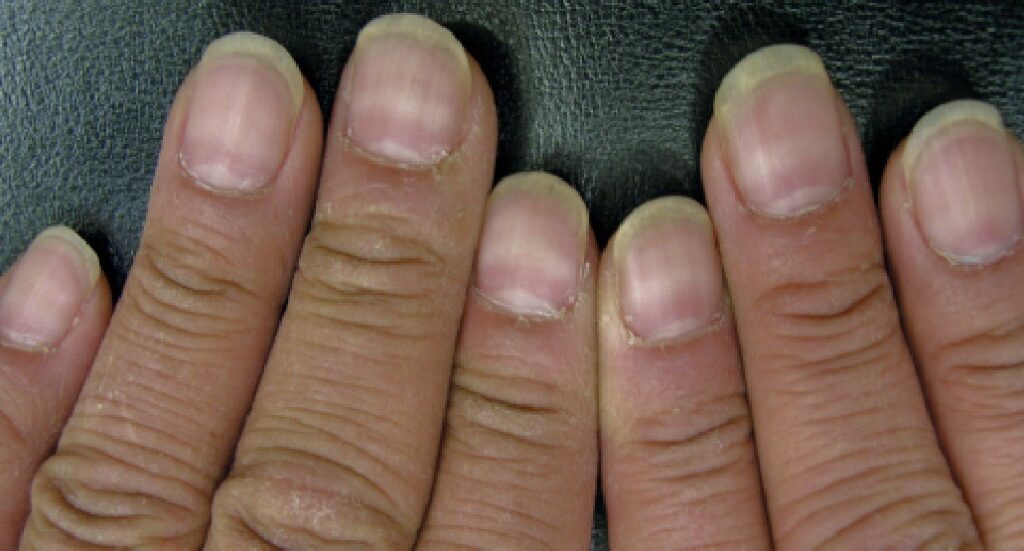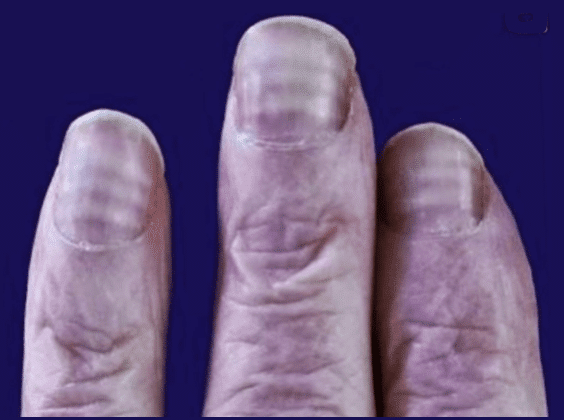Muehrcke lines
Description
Muehrcke lines are an apparent leukonychia which appear as twin transverse lines across the nail. Muehrcke’s nails (or Muehrcke lines) are a disorder of the nail bed which can be a reflection of systemic disease. There is no nail surface irregularity; the lines can be seen, but not felt; and do not progress up the nail with nail growth
Muehrcke lines create a distinct pattern of paired, white, transverse lines that usually spare the thumbnail and are most commonly in seen in association with hypoalbuminaemia (e.g. cirrhosis, glomerulonephritis, nephrotic syndrome); metabolic stress (e.g. AIDS and systemic infection); chemotherapy; trauma and high altitude.
Muehrcke’s nail sign secondary to low albumin may be reversible with a rise in serum albumin levels.
The smooth paired white bands run parallel to the distal lunula across the whole breadth of a nail, and are most prominently on the second, thirds, and fourth digits.
These white bands involve the vascular nail bed not the nail matrix itself, hence Muehrcke lines do not move with nail growth, and applying pressure to the affected nail will appear to fade these lines as the underlying nail bed is blanched (apparent leukonychia).
The mechanism is not well understood, but thought to involve compression of the vascular structures in the nail bed due to local oedema.

Steven Q. Wang, MD (Consultant 360)
Muehrcke’s lines are most commonly associated with metabolic stress and chronic hypoalbuminaemia (usually < 2 g/dL), such as nephrotic syndrome, chronic liver disease, or severe malnutrition. In addition, Muehrcke’s lines have also been associated with infections, chemotherapy drugs, and high altitude.

History of Muehrcke lines
1956 – First described in an article published by Robert C Muehrcke (1921-2003) in the British Medical Journal.
Abnormal changes in the finger-nails often provide evidence of systemic diseases. This paper calls attention to a hitherto undescribed change which has been related to severe hypoalbuminaemia. This is the appearance of paired narrow white bands in the finger-nails of patients with serum albumin levels persistently below 2.2 g. per 100 ml.
These two transverse bands run parallel to the lunule. They are not palpable, do not indent the nails, and are separated from each other and from the lunule by areas of normal pink nail. The distal white band may be slightly wider than the proximal band.
Muehrcke 1956
Out of 32 patients recruited with paired white bands on the fingernails, Muehrcke observed that 23 had nephrotic syndrome and another 9 had hypoalbuminemia from other causes. These lines appeared only when serum albumin levels were less than 2.2 g/dL.

These lines disappeared in 4 patients treated with intravenous albumin or corticosteroids until their serum albumin increased to greater than 2.2 g/dL. Muehrcke thought these lines were due to “chronic nutritional deficiency of albumin” and thus suggested that its presence could be used to distinguish between hypoalbuminemia and cardiac dysfunction in the oedematous patient.
1979 – Schwartz and Vickerman publish case report of a 64 year old woman with lung cancer on multiple cytostatic agents, but normal serum albumin levels, who developed Muehrcke’s lines representing chemotherapy-induced nail abnormalities
1998 – Nabai publishes first report of Muehrcke’s lines in a heart transplant recipient in the context of hypoalbuminaemia. In his personal account, he noted that the histological section of his nail plates demonstrated orthokeratotic keratinous material and areas suggestive of delayed keratinization.
2001 – Case of Muehrcke’s lines was reported in a patient following left ventricular assist device (LVAD) implantation with hypoalbuminaemia (2.7 mg/dL).
2009 – Windsor et al publish as case study on Muehrcke’s lines observed in a healthy subject after ascent to 8848 meters on Mount Everest

Multiple narrow, parallel, white transverse bands that disappeared on blanching. The bands were nonpalpable and separated by normal pink nail
Associated Persons
- Robert Carl Muehrcke (1921-2003)
Alternative names
- Muehrcke’s lines
- Muehrcke’s nails
- Muehrcke’s striae
- Apparent leukonycia striata
Other eponymous nail signs
References
Original articles
- Muehrcke RC. The finger-nails in chronic hypoalbuminaemia; a new physical sign. Br Med J. 1956;1(4979):1327-8
Review articles
- Schwartz RA, Vickerman CE. Muehrcke’s lines of the fingernails. Arch Intern Med. 1979;139(2):242.
- Nabai H. Nail changes before and after heart transplantation: personal observation by a physician. Cutis. 1998; 61(1): 31‐32.
- Morrison-Bryant M, Gradon JD. Images in clinical medicine. Muehrcke’s lines. N Engl J Med. 2007;357(9):917.
- Weiser JA, Rogers HD, Scher RK, Grossman ME. Signs of a “broken heart”: suspected Muehrcke lines after cardiac surgery. Arch Dermatol. 2007 Jun;143(6):815-6
- Morrison-Bryant M, Gradon JD. Images in clinical medicine. Muehrcke’s lines. N Engl J Med. 2007 Aug 30;357(9):917
- Windsor JS, Hart N, Rodway GW. Muehrcke’s Lines on Mt. Everest. High Alt Med Biol. 2009;10(1):87‐88.
- Short N, Shah C. Muehrcke’s Lines, Physical findings. 2010; 123(11): 991-992
- Sharma V, Kumar V. Muehrcke lines. CMAJ. 2013;185(5):E239.
- Robert C, Sibaud V, Mateus C, et al. Nail toxicities induced by systemic anticancer treatments. Lancet Oncol. 2015;16(4):e181‐e189.
- Tavares NT, Costa A, Damasceno M. Muehrcke’s lines. Autops Case Rep [Internet]. 2018;8(1):e2018014
- Zhang G. Muehrcke lines, Eponym A Day. Instagram
[cite]

eponymictionary
the names behind the name
Doctor in Australia. Keen interest in internal medicine, medical education, and medical history.

